Abstract
The myth of Sīyāvuš is one of the oldest and most important in the Iranian world and many rituals are related to it. Sīyāvuš is a deity of plants whose death and annual resurrection guarantees nature’s rebirth after cold seasons. To this day, it remains a powerful influence in Iran and Central Asia thanks to the legends that have sprung up from it. This paper describes some of these legends, collected during a fieldwork trip in 2018, and reinterprets them in reference to this myth.References
Anyaví Shirazí, A. Q. (1984). Ferdousinamé [Libro de Ferdousí] (vol. 3). Teherán: Elmí.
Ashraf, A. (2008). Hoviat-e iraní be se ravayat [Tres perspectivas de la identidad iraní]. Irannameh, (24), 1-21.
Avestá (2013). (Ed. y trad. Y. Dustjah) (2 vols.). Teherán: Morvarid.
Bahar, M. (2014). Pajuheshi dar asatire irán [Indagaciones en la mi¬tología irania]. Teherán: Agah.
Beizaí, B. (1965). Namayesh dar irán [Teatro en Irán]. Teherán: Kavián.
Biruní, A. R. (1984). Asar-ul-bagiyah’an quroon-ul-khaliya [Las huellas conservadas de los siglos pasados] (3a ed.) (Trad. A. Danaseresht). Teherán: Amir Kabir.
Dadaguí, F. (2012). Bundahišn (Ed., trad., introd. y notas M. Bahar). Teherán: Tus.
Ferdousí, A. Q. (2015). Shahnamé (vol. 1) (Ed. Y. Jalequí Motlagh). Teherán: Soján.
Hosurí, A. (2006). Siyawushán (2a ed.). Teherán: Cheshmé.
Mazdapur, K. (2004). Tadavom-e adab-e kohan dar rasmhaye moasere zartoshtián dar irán [Vigencia de viejas narrativas en los rituales zoroastrianos contemporáneos]. Farhang, 49-50, 147-179.
Meskub, S. (2007). Hoviat-e iraní va zaban-e farsí [La identidad iraní y la lengua persa]. Teherán: Pajuhesh Farzán Ruz.
Narshají, A. B. M. bin Y. (1984). Tarij-e Bojará [La historia de Bujará] (2ª ed.) (Ed. y notas S. M. T. Modarres Razaví; trad. A. N. A. bin M. bin Nasr Alqabavi,). Teherán: Tus.
Ne’mat Tavusí, M. (2013). Siyawash va izad-e nabatat. En G. Dabiri y O. Grabar (Eds.), Shahnamé va pajuhesh-haye tazé: pi-ramune tarikhnegari, honar va jame.eye iraní [El Shahnamé y nuevas investigaciones: acerca de la historiografía, el arte y la so-ciedad iraníes] (Trad. M. Fazelí Biryandí) (pp. 49-66). Teherán: Payán.
Razí, H. (1992). Gahshomarí va yashnha-ye iran-e bastán [El conteo del tiempo y las festividades del Irán antiguo]. Teherán: Behyat.
Tabarí, M. b. Y. (1990). Tarij-e Tabarí [La historia de Tabarí]. (Trad. A. Qasem Payandé) (vol. 1). Teherán: Asatir.
Tha’alibí Neishaburí, A. (1970). Tarij-e Tha’alibí: Ghurar Akhbar Muluk al-Furs wa Siarihim [La historia de Tha’alibí: crónicas de los reyes persas y sus hazañas]. (Trad. y nota preliminar M. Fa-zaelí; introd. H. Zotenberg). Teherán: Noqré.
Tolstov, S. P. (1984a). Древний Хорезм: Опыт историко- археологического исследования [Antigua Corasmia. Ensayo de investigación histórico-arqueológica]. Moscú: msu.
Tolstov, S. P. (1984b). По следам древнехорезмийской цивилизации [Siguiendo las huellas de la antigua civilización de Corasmia]. Moscú: msu.
This work is licensed under a Creative Commons Attribution-NonCommercial-NoDerivatives 4.0 International License
Copyright 2022 Estudios de Asia y África


